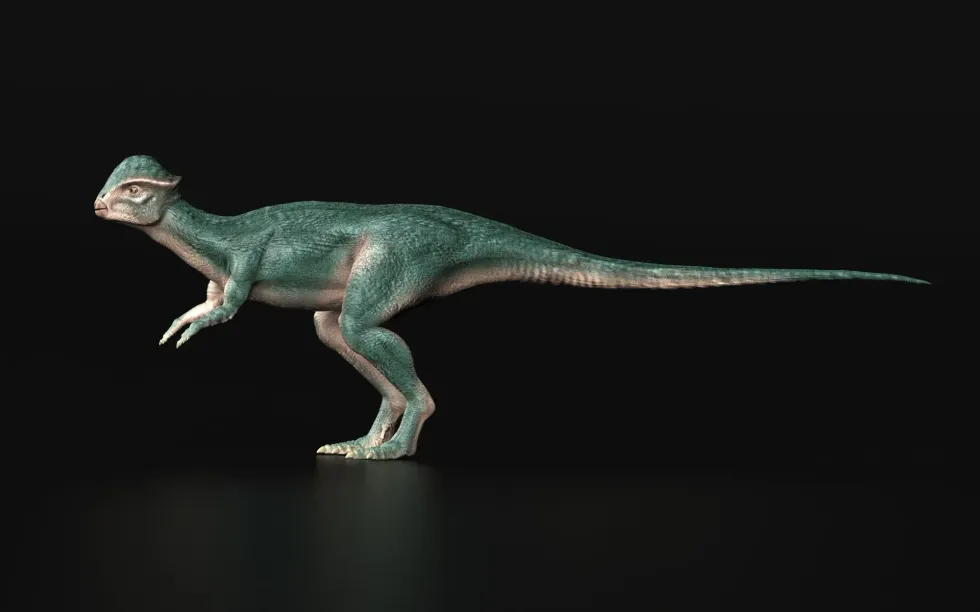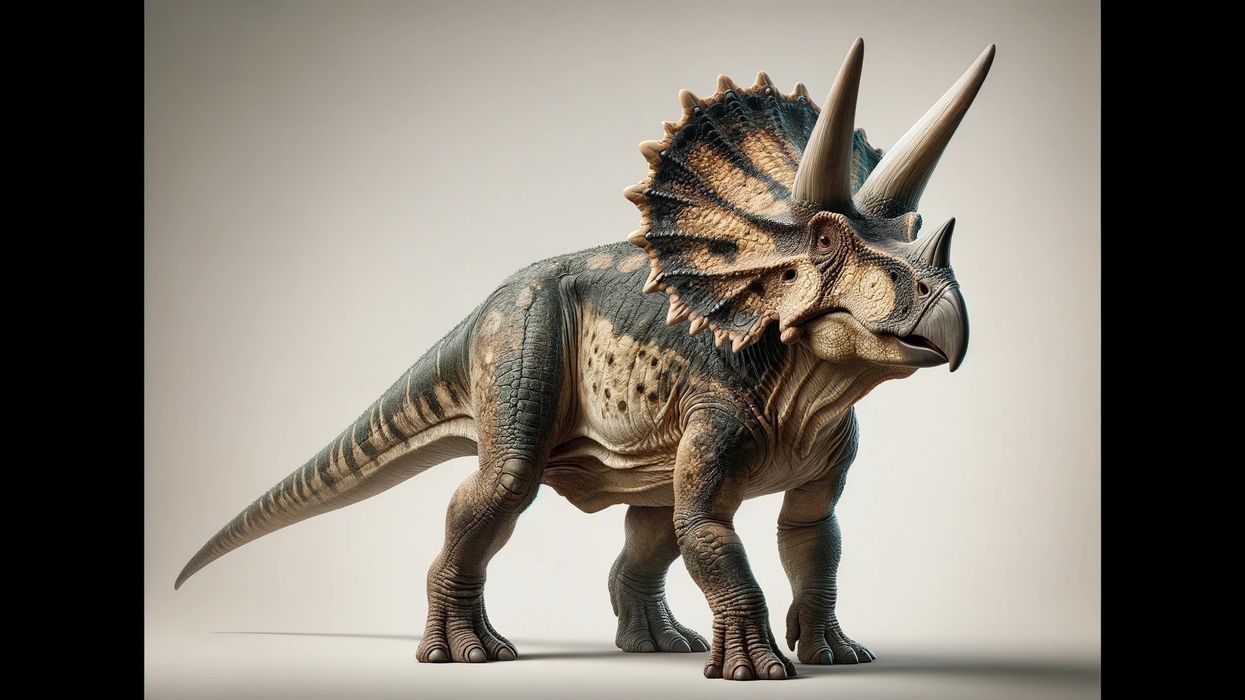Stegoceras validum lived during the Late Cretaceous period, 75 million years ago. This dinosaur fossil was found in Canada and New Mexico.
The description of their fossils showed that they were dome-headed. They had knobs and bumps on their head and protruding ridges at the back of their head.
This dome-headed dinosaur was a herbivore with small teeth placed in rows and it fed on plants, fruits, seeds, and insects. It was a bipedal dinosaur and when it comes to its classification, it was part of the Pachycephalosauridae family and the Stegoceras genus.
If you like reading about the Stegoceras, also check out these interesting facts about the Monoclonius and the Shunosaurus!
Stegoceras Interesting Facts
How do you pronounce 'Stegoceras'?
Stegoceras is pronounced as 'steg-oh-seh-rass'.
What type of dinosaur was a Stegoceras?
The Stegoceras was part of the Pachycephalosaurs family, of the phylum Chordata and genus Stegoceras.
In which geological period did the Stegoceras roam the Earth?
The Stegoceras lived during the latter part of the Late Cretaceous Period. These dinosaurs lived 75 million years ago. It lived during the time period known as the 'Age of Reptiles'.
When did the Stegoceras become extinct?
The Stegoceras became extinct when a large meteor hit the Earth and led to the death of all dinosaurs. They became extinct around 150 million years ago.
Where did the Stegoceras live?
The Stegoceras lived in North America; New Mexico, Alberta, and Canada, where it was first discovered.
What was the Stegoceras' habitat?
The Stegoceras' habitat has been described as consisting of swampy rivers, floodplains, and coastal plains. Since they were herbivores, they lived in areas with a good density of vegetation.
Who did Stegoceras live with?
The Stegoceras validum was a bipedal dinosaur that lived as a member of herds or groups with its conspecifics.
How long did a Stegoceras live?
The lifespan of a Stegoceras validum, or any other Pachycephalosaurs, has not been estimated yet. It has been concluded that the skull size increased with age. The skull was almost flat in juveniles and curved outward, and as the dinosaur grew older, the skull would continue to grow a few inches thicker.
How did they reproduce?
Very little information is available on the subject of Stegoceras validum reproduction. These dinosaurs probably had a fixed breeding season and laid eggs like other dinosaurs. Dinosaurs are oviparous, and internal fertilization takes place after breeding. The juveniles hatch from the eggs after an incubation period.
Stegoceras Fun Facts
What did the Stegoceras look like?

The Stegoceras' skull was roughly triangular in shape from the side. The Stegoceras had a short snout and a thick, broad, and smooth skull on the top, which resembled domes.
The back of the skull or head had a thick shelf or ridge protruding and had a thick ridge on the brow over the eyes. The skull was 3-4 in (7.62-10.16 cm) thick in males and thinner in females and juveniles.
Most of the skulls had small protrusions or round outgrowths and knob-like nodes in many rows. This gave the effect of the dinosaur having a shelf-like protrusion on the back of the head, with the largest horns lining together to create the shelf.
The Stegoceras had teeth that were differentiated and placed in sockets.
The small teeth were placed in rows and obliquely along the edge of the jaw. The skull domes are flat in juvenile animals and developed into domes as the dinosaurs grew older.
The Stegoceras dinosaur had a stiff vertebral column and tail, with a broad pelvic region. The tail was around half the body length, 3-4 ft (0.91-1.21 m) long.
How many bones did a Stegoceras have?
The exact number of bones in the Stegoceras dinosaur is not known because no complete specimen has been found. Only one complete skull, along with a few other bones of the Stegoceras validum species, was discovered. An incomplete skull and a few bones were found of the other related Stegoceras dinosaur species, Stegoceras novomexicanum.
How did they communicate?
Like other dinosaurs, it can be assumed that the Stegoceras dinosaur communicated using their rounded skulls and vocalization. Dinosaurs created distinct open-mouthed sounds and closed-mouthed sounds.
The dinosaur groups of phylum Chordata from class Dinosauria, which all have a Stegoceras skull head dome, used it during mating rituals to choose and impress mates, to scare rival dinosaurs, or to dominate other dinosaurs in the herd. They used it for head-butting and flank-butting.
How big was the Stegoceras?
The Stegoceras was a small dinosaur whose size was comparable to a modern-day goat. The Stegoceras is 8 ft (2.13 m) and 4 ft (1.22 m) tall.
Its tail is around half its body length; 3-4 ft (0.9-1.22 m). This dinosaur is four to five times larger than an English Shepherd and is twice the size of a wild goat.
How fast could a Stegoceras move?
The Stegoceras dinosaur could move quite quickly. Their primary defense and instinct were to run away from predators or when they perceived any threat. They could run at speeds of around 15 mph (24 kph). It was a bipedal dinosaur; which means it could run or walk using two of its hind limbs.
How much did a Stegoceras weigh?
Since the Stegoceras was a small animal, it didn't weigh much either. The herbivorous dinosaur's weight was a maximum of 121 lb (55 kg). It's eight times lighter than an Arabian stallion and around the same weight as a blue sheep.
What were the male and female names of the species?
This dome-headed dinosaur doesn't have sex-specific names for the male and female of its species. This dinosaur species exhibits sexual dimorphism and could be distinguished visually. The males were larger and heavier, with a thicker dome on their skulls. The females also had smaller horns and knobs on their skulls.
What would you call a baby Stegoceras?
There is no particular name for a baby Stegoceras. They are generally called juveniles or babies.
What did they eat?
Researchers think that the Stegoceras was a herbivore because it had tiny teeth which could not have chewed or torn any raw meat or hard food. This herbivorous dinosaur probably ate plants, fruits, seeds, and insects.
How aggressive were they?
After examining the injuries of the Stegoceras skeleton fossil, researchers concluded that they fought by butting heads or flank butting. They seem to have both offensive and defensive tactics.
Initially, scientists believed that when attacking, they would butt heads and fight for dominance regarding territory with conspecifics and other similarly sized animals. In defense, they would run away from other larger dinosaurs that could prey on the Stegoceras.
It was later deduced that they could not head butt because of the rounded bone skulls, which would glance off. Their necks were U-shaped or S-shaped, which couldn't be straightened to hit another animal.
Did you know...
The Stegoceras validum fossil is called UALVP 2. Most of the information known about this dinosaur has been obtained from the remains of these fossils. It is the only fossil found with a complete skull and bone.
The classification of the Stegoceras was widely debated and it went through numerous taxonomy changes since its initial discovery in 1902. It was considered to either be ceratopsian, or stegosaurs.
Why are they called Stegoceras?
The name Stegoceras means 'horny roof' or 'horned roof'. It refers to the hard dome-shaped heads common to this species. The bone heads were assumed to have been used like horns to attack rivals. The Latin name Validus means 'strong', which probably referred to the thick bone present on their skulls.
Who discovered the Stegoceras?
Lambe discovered the Stegoceras genus in 1902. The specimen he discovered was named Stegoceras validus. Later, in 2011, Jasinski and Sullivan named a specimen found in New Mexico, Stegoceras novomexicanum. The inclusion of this specimen as a different species of reptile in the genus was widely debated upon. Most researchers believed that the specimen is a juvenile S. validum.
Here at Kidadl, we have carefully created lots of interesting family-friendly dinosaur facts for everyone to discover! Learn more about other creatures from our Tylocephale facts and Alaskacephale facts pages.
You can even occupy yourself at home by coloring in one of our free printable Stegosaurus coloring pages.









